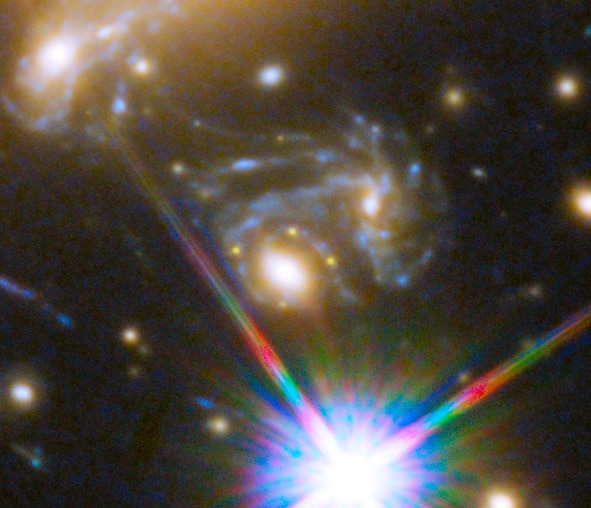Create a free profile to get unlimited access to exclusive videos, sweepstakes, and more!
Einstein’s Magnifying Glass Splits a Supernova Into Four Pieces

Astronomers marked a milestone last week when they observed a supernova, an exploding star, halfway across the Universe. We see these all the time, but the reason this particular one is significant is, literally a twisted tale.
First, here’s the extremely cool image of the supernova:
That’s a Hubble Space Telescope shot, part of a much larger image showing a cluster of galaxies over 5 billion light-years distant. Almost everything in this picture is a galaxy (the very bright cross-haired object is a star in the foreground, in our own galaxy).
The central part of the picture is magnified in the inset, and the star is indicated by arrows. But wait a sec. Why are there four arrows?
Because each of those is an image of the exploding star! The light from the star traveled for billions of years to get here, and on its way here the road split. More than once.
Here’s how that works. The star is in a spiral galaxy well over 9 billion light-years from Earth. It exploded, sending light out in all directions. On its way to Earth, some of that light passed through the galaxy cluster. The gravity of that cluster is immense (due to the mass of stars and gas in it, as well as lots of dark matter), and it warps space. As the light from the supernova moved through the cluster, it followed that bending of space; twisting and turning with it. That alone would be enough to distort the image of the supernova and its host galaxy.
But then there was an added surprise: Some of that light passed very close to a massive elliptical galaxy in the cluster. That strongly warped the light, bending it such that we get multiple images of the star. Think of it this way: As you look at the image, some of the supernova’s light was heading off to the left of the galaxy, and if it had kept going that way would’ve missed Earth, and we’d see nothing, but the galaxy’s mass bent the light’s path, aiming it toward us. The actual details are quite complicated, but this can create multiple images of a single object; in this case four of them.
We call this effect gravitational lensing (I’ve written about it multiple times—haha—like here, here, here, and here, and you should click those for more info as well as awesomely cool images of lensing), and it was predicted by Einstein under his theory of relativity. We’ve seen it many times, but never before has a supernova been under such a lens. This is a first.
It gets better. The light gets magnified, so that we can see the supernova more easily; in this case it’s about 30 times brighter than it would have been without lensing. And there’s yet another benefit: Because the light has taken different paths to get to Earth, we see time delays between each.
Actually, the Hubble site has a great analogy for this:
The supernova's various light paths are analogous to several trains that leave a station at the same time, all traveling at the same speed and bound for the same location. Each train, however, takes a different route, and the distance for each route is not the same. Some trains travel over hills. Others go through valleys, and still others chug around mountains. Because the trains travel over different track lengths across different terrain, they do not arrive at their destination at the same time. Similarly, the supernova images do not appear at the same time because some of the light is delayed by traveling around bends created by the gravity of dense dark matter in the intervening galaxy cluster.
Cool, huh? Interestingly, in the big picture of the cluster, you can actually spot at least two other images of the star’s host spiral galaxy; the galaxy light was lensed and multiplied too. It’s bizarre, but extremely useful to astronomers. The amount of bending and the time delays involved provide a way to measure how much mass is in the cluster, how it’s distributed, and also how fast the Universe itself is expanding! That last part comes out because of the great difference in distances between the supernova and the cluster; the expansion of the Universe affects how the light travels between them and to us, so measuring the delays gives us another way to measure the cosmic expansion.
Models of the cluster made by the astronomers who made this discovery indicate that other images of the galaxy may come from paths that are taking longer to get to Earth, so in them we still see the galaxy before the supernova went off. That means in a few years we may get to see the explosion rise again, as if the Universe itself were set on rewind. That’s a very rare opportunity; to know when and where a star will explode!
I find this all quite delightful. The distant Universe is extremely difficult to study because, duh, it’s far away. Things are small and faint. Gravitational lensing allows us a chance to take a narrow but deep slice of that distant realm, and see it better than we could have before. It’s a happy circumstance that astronomers are all too thrilled to capitalize upon.


























